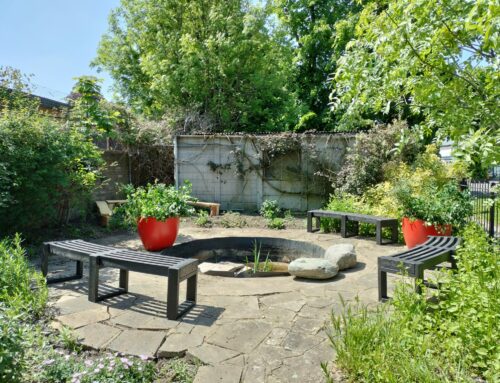Did you know we have a resident gardener/plant whisperer? What she doesn’t know about gardening isn’t worth knowing, and she’s been shouting about the benefits of raised bed growing for years. Here’s why…
“For decades, growing your own vegetables and fruit was far from fashionable. We imagined the typical allotmenteer to be a pensioner with plenty of time, pottering in their allotment planting potatoes, cabbages and carrots – hardly inspiring foods for broad-minded 21st century humans. The shift towards colourful and exciting fruit and veg came along in the last decade, with several factors that contributed to the growing boom. More restaurants were opting for contemporary foods and introducing new varieties to their menus, with oca, pineberries or microgreens being stars of the show. With the new dining fashion, those who already grew their own started venturing out into rarer and rarer breeds, experimenting and trying out what they previously thought would be exclusive to professional glasshouse growers. An explosion of Instagram influencers has shown vegetables in a new light – with bright filters, exciting close-ups, sunsets in the background and an overall feeling of bliss and simplicity – things that have been missing in the busy lives of many. Allotment waiting lists saw soaring interest when the pandemic hit last year, with private plots quadrupling their annual rental cost, timber merchants running out of wood, and many urban and suburban gardens changing things around to accommodate a raised bed or two.
When I think of my mum and gran, who have been keen growers for decades, I hardly remember anyone adopting the concept of growing in a raised bed. Traditionally, the soil would be heavily tilled, dug over once or twice, neat rows would be marked out with narrow paths in between and the crops would be rotated every year. Nowadays however, raised beds in all forms seem to be the most popular choice amongst growers and for a few good reasons”.
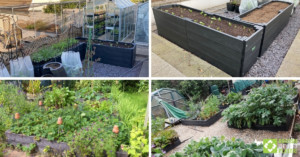
A selection of our zero-maintenance, lifetime-guaranteed raised bed kits.
Work in comfort with raised beds
“The first and most obvious thing that comes to mind is of course the height. Traditional veg patches would have been at ground level, which eventually will be problematic for those of us who aren’t as nimble as they were in their teens. Back injuries and limited flexibility make it difficult to tend to such a bed, be it for weeding, sowing or digging if that’s your thing. And if you didn’t have a back injury when you started, you’d likely soon join the club with all that floor-level work… With your grow bed raised from the ground, you’re more comfortable to perch on its side and tend to it, without too much strain. This may sound like a small issue for most of us, but even the smallest, yet repetitive strains on our back can prove problematic in the future. Different heights can be useful to people with various needs. The low ones are great for ease of weeding and to give extra depth to the soil; waist height ones are popular with people who have mobility issues or struggle to bend down much. Of course, a thing to take into consideration is that the depth of the bed will dictate how much soil you need to fill it with – the deeper the bed, the more soil you’ll need, and so the higher the initial cost will be. Saying that, it’s an investment for years to come and many successful harvests come from deep, rich soil. If you want just the height without the depth, it’s worth looking at trough-style beds, which are raised off the ground on legs and the trough at the top provides a growing space. These are particularly useful for wheelchair users or elderly growers who may need to use a chair to fit below the growing space, making it easier to tend without stretching far out to reach the plants”.
Hugelkultur – how to avoid digging
“For those of us who follow the rapidly growing movement of ‘no-dig’, raised beds seem to be the perfect solution. Traditionally the veg beds would be walked over to plant and harvest, which compacts the soil beneath. This makes it more difficult for water to run off, for worms and soil animals to create new burrows and for the roots to spread. With no digging involved and only layering new compost and manure on top of the existing surface, leaving the worms to do the digging job for us, we can add a much larger amount of soil without it spilling down the sides. Structurally it makes sense, but also if we want to take more control of what’s inside such a bed, we can plan a much better garden for ourselves. Depending on the soil quality in your space, you can create a bespoke environment for your crops. Brassicas (the cabbage family) prefer clay soil, so their roots can anchor firmly and support stalks full of heavy sprouts, whereas root vegetables prefer more sandy soil, which is easier to mix in the bed. Having raised beds allows us to mix sand, clay, compost or even fresh organic matter in higher proportions than if we just incorporated it into the ground.
A method worth exploring in conjunction with having a raised bed is called Hugelkultur, which translates to ‘hill mound’. It incorporates dead wood and organic material like brash and manure, layered and covered with compost on top, slowly decomposing the wood whilst adding nutrition to the soil. This method is easy to incorporate into raised beds, keeping ‘the mound’ in a uniform shape and allowing for the additional layers of organic matter to be laid on top every season”.
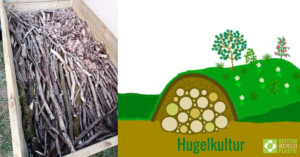
Protect your plants
“With the climate being somewhat different in recent years to the one our grandparents were used to, raised beds also bring another advantage to the growing game – protecting their crops from all angles. To start with, it makes it more difficult for an army of slugs to casually slide into the bed and demolish our lovingly nurtured seedlings. Weather wise, the danger of frosts can be pushed away with the height of the bed itself – frost ‘travels’ across ground level, so raising the plants is beneficial. Additionally, the bed can be covered with horticultural fleece to protect from sudden cold spells or with butterfly netting to prevent Cabbage Whites from laying eggs on our brassicas. During the winter months, a simple structure of bamboo canes and hoops can act as a support for plastic sheeting like a one-bed polytunnel, to give extra protection and warmth to the plants. Winter and spring often see localised floods, with many plots submerged in a few inches of water for a short period. Having the plants raised up protects them from waterlogging. If you’ve opted for beds made from recycled plastic, you can take advantage of the dark colour which best absorbs the heat of the sun. In spring it will warm the soil in the bed faster, letting us germinate the seeds earlier and enjoy a longer growing season. The same warmth-absorbing properties of recycled plastic would be beneficial in compost bays. Compost naturally heats up when the fungi and bacteria start the decomposition process, but it quickly cools down after. In this cool stage, worms, beetles and other animals move in to break up the organic material further. Worms are most active between 10C and 25C, so even what seems a cool day to us may have a positive effect on them. In the coldest days of winter, worms will travel into the middle of the compost pile to benefit from the heat. Additional heating of the black plastic from the sun will warm the overall area they can spread to, breaking the organic matter down faster and creating rich compost, just in time to top our beds up before a new growing season”.
Better roots, better fruits!
“Perhaps the most beneficial advantage of having plants growing in raised beds as opposed to in the ground, is the fact that the roots of the plants can grow deeper and healthier. With control over the soil we have in the beds, the roots can spread freely and reach farther than in the harder soil. Watering such beds gives enough moisture to the roots, and allows the excess to run off freely. Roots which have sufficient water and oxygen will be stronger and absorb more nutrients from the soil, in return giving us generous harvests. Roots which sit in wet soil for longer periods abdicate the responsibility to grow and therefore absorb nutrients. A common sight during prolonged periods of rain is a yellowing of the plants. One would think that this is due to nutrient deficiency, however it is in fact a case of ‘nutrient lockout’, where the nutrients are indeed available in the soil for the roots to uptake, however the presence of excess water just dilutes them to such extent that the plant struggles to uptake any at all. Imagine getting a teabag, a dash of milk and a spoonful of sugar to perk yourself up with a cup of tea, but being told you can only make the tea using a full bath of water – you’d hardly be able to drink enough to feel any benefit at all. Looking after the roots is crucial for any plant – the popular saying ‘better roots, better fruits’ didn’t appear from thin air!”.
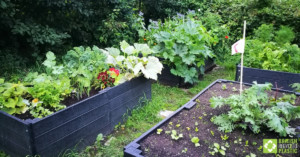
600mm beds give extra depth and are perfect for working from a sitting position.
“Whether you decide to go the traditional way and grow in the ground, or install some raised beds, the best solution for your garden or your body is different for everyone. One thing is for sure though: gardening is addictive, so whatever you do, make sure you leave some space for more beds to come in the future”.
Zero-maintenance raised bed kits
Our recycled plastic planks, posts and decking boards will never rot, split or splinter and need no maintenance or treatment whatsoever. Imagine that – no maintenance! With a one-off spend and installation, you can enjoy decades of faithful service without any of the niggling annual repair and maintenance tasks.
Our raised bed kits are the right choice for the vast majority of our residential customers. We’ve designed them with you in mind, to ensure delivery and assembly are as easy as possible. Whatever the size of your raised bed kit it will fit on a single pallet and can be delivered by a smaller vehicle wherever necessary. All you need for assembly is a couple of pairs of hands and an adjustable spanner – all fixings are provided. All our kits comprise a combination of 1m and 500mm panels, but if you can’t find the size or configuration you want on the webshop, give our friendly team a call and we’ll get you fixed up. Of course, you can still build your own beds, if you prefer. Take a look at our price list for the full range of lumber profiles and send us a cutting list for a rapid quote.
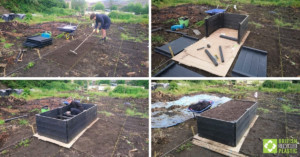
Assembly couldn’t be simpler!
The sustainable choice
Our raised bed kits are engineered from 100% solid recycled plastic, making them a more sustainable choice than their composite equivalents. Composite boards tend to combine plastic with sawdust to reduce cost and weight, but the sawdust element is still vulnerable to rotting – although composite lasts longer than timber, it will need replacing in time. A central tenet of sustainable practice is to minimise the amount of new materials in circulation, to buy once and buy well. You can be assured that our raised beds will be the last you’ll ever buy, thanks to our lifetime guarantee.
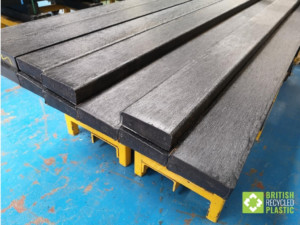
100% solid, recycled plastic.
Safe for your garden
British Recycled Plastic planks, posts and boards won’t leach any chemical nasties into the soil and are safe for even the most delicate of environments: the Environment Agency have used our material in several of their SSSIs. Choose black (rather than brown) and your crops will benefit from the thermal storage properties of our lumber – seeds will germinate and grow faster and your raised beds will recieve a little extra frost protection. Our raised bed kits are resistant to UV-fading, as well as to the growth of mould and algae.
Why choose British Recycled Plastic?
Our plastic is manufactured in the UK, from British-sourced waste plastic. We don’t ship overseas because we want to reduce our own waste mountain and keep our corner of the plastic recycling economy as circular as possible. We’ve been around for a long time and are trusted by many large organisations, including NHS, MoD, Highways England, National Trust and countless schools and councils up and down the land.
Get in touch!
If you want to take a look at our full range of raised bed kits, the webshop is your first stop.
01422 419 555
Our guest blogger
Martyna Krol is an organic grower passionate about food and sustainability.
Through her work at Incredible Aquagarden she taught urban farming and permaculture techniques to students of all ages.

Our resident gardener, Martyna Krol.


